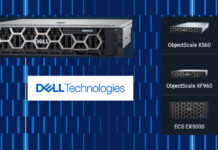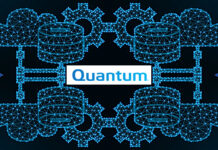New Zealand startup Novodisq demonstrated ultra high-capacity SSD storage at the FMS 2025 summit, showing an 11.5 PB 2RU blade server with onboard AI processing.
The hyperconverged, cluster-in-a-box Novoblade server is designed to replace or complement traditional NAS, SAN, and public cloud offerings. It supports platforms like Ceph and Nextcloud, exposing NFS, iSCSI, and S3-compatible APIs.

A server contains 20 front-loaded Novoblade modules, each having 576 TB capacity provided by four onboard Novoblade 144 TB E2 format SSD drives, built with TLC NAND and having a PCIe Gen 4 x 4 bus connection. The drives support NVMe v2.1, NVM, and zoned namespaces, and provide up to 1,000 MBps sequential bandwidth and 70,000/30,000 random read/write IOPS. They support 24 PB of lifetime writes.

These modules combine compute, acceleration, and storage capacity. The server can run standard Linux distributions (RHEL and Ubuntu LTS) and supports Docker, Podman, and QEMU/KVM orchestration via platforms like Portainer and OpenShift.
The drives, modules, backplane, and Novoblade server have all been developed by Novodisq, and the system is intended for warm and cold data storage. It has built-in FPGA hardware, encryption, accelerated AI/ML, video decoding, plus container orchestration, and is purpose-built for data heavy environments like genomics, geospatial imaging, video archives, and edge AI.

The system is powered by AMD Versal G2 SoCs, providing adaptable compute and optional AI/ML acceleration. Customers can choose AI or FPGA modules for inference, compression, or edge analytics workloads.
We’re told: “Each Novoblade module integrates an Adaptive SoC and four directly mounted E2 SSDs, two on each side. This allows a module to function as a standalone Linux server when inserted into the enclosure. Novoblade modules are designed to be clustered, with resources orchestrated via high-availability systems like Ceph and Kubernetes.”

There is built-in networking support for up to 400 Gbps total throughput, with RoCEv2 RDMA, TSN (Time-Sensitive Networking) support, and hot-swappable 100 Gbps uplinks. The system can start with one Novodisq module and scale up to 20, then scale out by clustering, with integrated 100-400 GbE links. There are options for RDMA, TSN, or SDN-based orchestration.
There is a suite of management options, including a built-in BMC with web-based GUI, CLI, and support for Ansible, SNMP, and Redfish APIs. Systems can be managed locally or remotely, integrated into your existing stack, or provisioned via Infrastructure-as-Code tools.
Novodisq says it delivers around 10x the density of a disk drive-based server and lowers the power usage by 90-95 percent with no need for mechanical cooling. It claims the system’s total cost of ownership “is typically 70-90 percent lower than traditional cloud or enterprise solutions over a 5-10 year period.”
“That’s due to several factors: reduced rack space, lower power draw, no data egress fees, minimal cooling, long life, and dramatically simplified management. Unlike the cloud, your costs are mainly fixed, hence predictable, and unlike legacy systems, Novodisq doesn’t require expensive licenses, external controllers, or constant refresh cycles. You get high performance, long-term reliability, and better economics from day one.”
Get a Novoblade spec sheet here.
For comparison, Dell PowerScale all-flash F710 and F910 nodes with 122 TB Solidigm SSD support, 24 bays in their 2RU chassis, and 2:1 data reduction provide almost 6 PB of effective capacity. The Novoblade server provides 11.5 PB, almost double that capacity.
Bootnote

Ex-Nyriad engineers Carl Gaylard, Robbie Litchfield, and Michael Hutchins founded Novodisq. Litchfield told us: “Novodisq was founded in 2018 to replace HDD NAS systems with all-flash systems, improving the data density, power efficiency and TCO for archival and warm data. After early PoCs, we began developing Novoblade in 2021.”
It was envisaged as “our sovereign data lake and data extraction platform. Our unique requirements led us to design a proprietary SSD form factor that, through independent development, arrived at a mechanical profile that was uncannily similar to E2. Following its formal publication, we adopted E2 to streamline interoperability and standards alignment.”
Litchfield noted: “The Novoblade G1 SSDs utilize PCIe Gen 4 links based on ecosystem maturity at project outset. Future revisions will track PCIe advancements in collaboration with our technology partners.”
Novodisq is the operating name and brand; Anovo Disque Limited is the legal entity and owner of all assets, IP and brands etc. Graham Gaylard, Carl Gaylard, Robbie Litchfield and Michael Hutchins are the founding shareholders, with Graham serving as our founding CEO. Douglas Paul was appointed as CFO in 2021.
The company is owned by its founder shareholders and two NZ VCs were invited in to provide early stage seed funding. The VC investors and the amount invested to date is confidential. There are no other associated parties with interests or other arrangements. Both Douglas and Graham are serial entrepreneurs with multiple interests in technology companies, so you may see other shareholdings and directorships. It expects to explore further external funding options later this year.
DAOS support is planned as a future addition. We understand the company is looking for sales partners.








